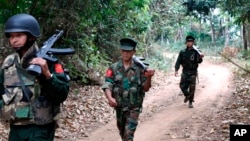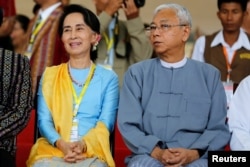Thousands of civilians remain displaced in northern Myanmar amid renewed fighting in recent weeks, many with little access to aid, bringing fresh concerns that the country’s peace process has stalled under the current government.
Fighting between the Myanmar army, known as the Tatmadaw, and the Kachin Independence Army, has seen local residents flee in at least three townships in Kachin State in recent weeks, local sources told VOA. Others have been pinned down by the fighting.
More than 150 people have been unable to leave an area of heavy fighting near Hpakant, a remote area renowned for the quality of its jade, local parliament representative Oo Choo told VOA by telephone.
“They haven’t been able to leave for a week,” he said.
Humanitarian aid
David Baulk, a human rights specialist with Fortify Rights, said thousands have been displaced by fighting in the past month.
“A lot of Kachin State is a war zone right now, and that’s what’s leading people to run for their lives,” Baulk told VOA. “The real issue when it comes to displacement in Tanai and other areas of Kachin State, is that the Myanmar government continues to systematically prevent aid groups from visiting these areas to provide basic services to people.”
Knut Ostby, United Nations Resident and Humanitarian Coordinator in Myanmar, released a statement last week condemning the latest violence in Kachin.
“I appeal to all parties to the conflict to allow displaced people and other civilians who may remain in the areas of conflict to be permitted to move to a more secure location of their choice and to allow for humanitarian assistance to reach these populations as a matter of urgency,” he said in the statement.
But government spokesperson Zaw Htay denied the military was denying access to aid for civilians caught up in the conflict.
“The government is already supporting humanitarian assistance for the Christians in the conflict,” he told VOA by telephone, before referring further questions to the Ministry of Social Welfare, Relief and Resettlement, who could not be reached for comment.
‘War crimes’
On April 23, a coalition of more than 30 Kachin civil society groups published a letter urging the United Nations Security Council to refer the Myanmar army to the International Criminal Court for its actions in the state.
“Despite their obligations, the international community, including members of the United Nations Security Council, have failed in their duty to uphold international law,” said the statement, which claimed that Kachin people had been subjected to “numerous violations” of international law.
The statement also claimed that at least three Kachin civilians, as well as one Karen community leader, had been killed in recent weeks.
“These are war crimes, but not one country has condemned these killings and promised to take action in response,” the statement said.
Peace process at a standstill
Since the National League for Democracy came to power two years ago, there has been little progress on the peace process, an issue that State Counsellor Aung San Suu Kyi said she would make a priority.
In February, two relatively small ethnic armed groups agreed to join the government’s Nationwide Ceasefire Agreement (NCA), but much of that progress has been offset by renewed fighting in Kayin State, home of the Karen National Union, perhaps the most influential of the two groups to have signed the NCA in October 2015.
It has been almost a year since the government last held its flagship event for the peace process, the 21st Century Panglong Union Peace Conference, the second such event held under the NLD. It has been rumored that the next event will take place in May, but that is yet to be confirmed.
“Holding a successful [Union Peace Conference] will require overcoming several obstacles, particularly lack of trust among the different parties,” Richard Horsey, an independent analyst, told VOA. “Without a sense of shared commitment to a process and negotiated outcome, it will be hard to revitalize the peace process and convene the next conference.”
Horsey said the peace process had “stagnated” and that there was frustration among signatories to the NCA, and skepticism among non-signatories towards signing the accord “until there are signs of greater political motivation and commitment to a negotiated political settlement.”
Nicola Williams, peace team leader at The Asia Foundation, agreed there had been a stalemate in political dialogue in recent years. She said that, while there had been much focus on the process of peace negotiations and cease-fire monitoring, there has been a “lack of emphasis and momentum on negotiations” to build policy solutions and the content of a peace accord.
“Nonetheless, while the peace process can seem like it’s on life support, outside of the headlines, outside of the political statements and stalemates, ethnic armed groups and conflict parties are making quite diligent efforts to discuss a lot of the core peace process issues, and to develop draft principles in preparation for the UPC,” she told VOA.









